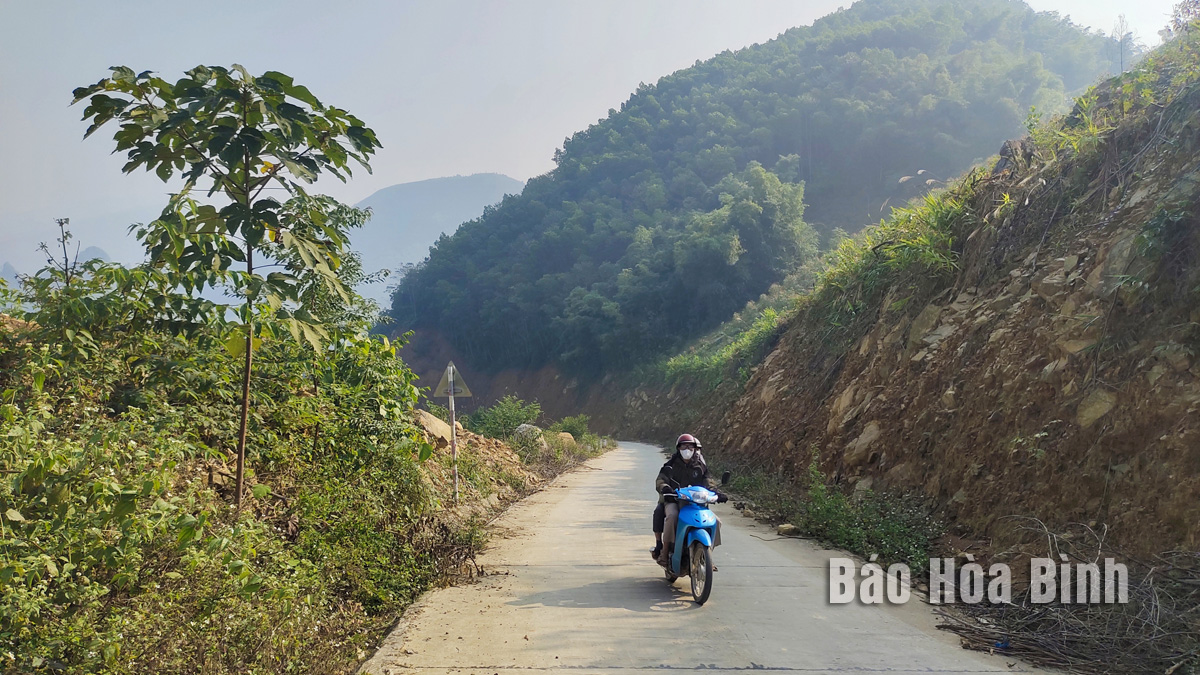
Thanks to the national target programme on new-style rural area building, the highland district of Da Bac has got a facelift and the material and spiritual lives of local residents have been improved.
A newly-built road from Tam village to Giang village in Cao Son commune.
According to a report of the Da Bac People's Committee, the district has four communes that have satisfied new-style rural building criteria. In recent years, through the new-style rural area building programme, the rural infrastructure system has been developed vigorously and the living conditions of rural residents have been improved.
Cao Son is one of the four communes in the district that has been recognised as meeting new-style rural area criteria. Coming to the commune, changes can be seen with roads being widened and concretised.
Dinh Van Lam, who resides in Giang village - one of villages that is far away from the commune centre, said in the past, people's lives faced many difficulties due to transport-related problems. Since the implementation of the new-style rural area building programme, roads in the village have been concreted, making it convenient for traders to come the village to buy agricultural products, he noted.
After the road connecting Giang village with Tam village was opened to traffic, it is easy for local residents to go to the commune centre to sell goods or make transactions at the commune People's Committee. Thanks to the road, many households have escaped poverty, and some even have been able to buy cars.
According to Ngo Van Cuong, Secretary of the Cao Son Commune Party Committee, to fulfil the criteria for new-style rural area building, in addition to the State's investment resources, it is necessary for people in the commune to enthusiastically respond to the movement.
Total capital mobilised to serve the commune's new-style rural area building programme for the 2010-2020 period was over 359 billion VND (14.6 million USD). Of which, local residents donated money, land and working days worth over 34 billion VND, Cuong said.
Cao Son is striving to meet standards for an advanced new-style rural area, he said, elaborating that 7 out of the 19 criteria have been fulfilled.
Bui Khac Vinh, Head of the district’s Division of Agriculture and Rural Development, said in 2023, four communes met 19 out of the 19 criteria, one fulfiled 15 out of the 19 criteria and 11 communes satisfied between 10-13 criteria. It also had three more products that were rated as three-star products under the One Commune One Product (OCOP) programme in 2023, raising the number of OCOP products to nine.
The district now has five model residential areas and 17 model gardens.
The official said the district has set specific goals for new-style rural areas building in 2024. They include improving the material and spiritual lives of local residents, linking agricultural development with industry and services as well as rural development with urban areas.
The district also rolled out solutions to achieve the goals which priotise fund for supporting the development of cooperative economic models and production linkage models in line with value chains to generate jobs and increase incomes for rural residents.
The communication work will be stepped up to mobilise the entire political system to join hands in building new-style rural areas, he said, adding that attention will be paid to implementing a number of criteria, especially those related to transport infrastructure, irrigation, schools, health stations, clean water, and the environment.
The Standing Board of the Hoa Binh provincial Party Committee has agreed in principle on a proposal by the Standing Board of the Party Committee of Hoa Binh city to gather feedback on the city’s 1:2000 zoning plan, which forms part of its broader urban development strategy.
Hoa Binh province has made notable progress in public administration reform and digital government development, with the satisfaction index among citizens and businesses reaching over 84%, according to recent government evaluations.
Thanks to great efforts by local authorities in recent times, the governance and public administration performance of Mai Chau district has been significantly improved.
In the afternoon of June 6, the Party Committee, the People's Council, the People's Committee and the Fatherland Front of Lac Son district solemnly held a meeting to celebrate the 139th anniversary of the district's founding (1886–2025) and the 79th anniversary of the establishment of the district's Party Committee (1946–2025). There was the attendance of Mr. Bui Van Thang, the Vice Chairman of the Provincial People's Council; Mr. Quach Tat Liem, the Vice Chairman of the Provincial People's Committee; Ms. Dang Bich Ngoc, the Deputy Head of the National Assembly Delegation of the province; as well as the former leaders of the province and district through various periods, who are the natives of the district.
Implementing the Politburo’s Resolution No. 57-NQ/TW on breakthroughs in science – technology, innovation, and digital transformation is a golden opportunity for the northern mountainous province of Hoa Binh to renew growth model, improve competitive edge and shorten digital gap.
Resolution 57-NQ/TW, issued by the Politburo on December 22, 2024, identifies sci-tech, innovation, and digital transformation as strategic breakthroughs to build a developed and prosperous nation. In Hoa Binh province, this spirit is not just a slogan, it’s being put into action through concrete initiatives that form a "new development triangle”: digital citizenship, digital economy, and digital administration.



